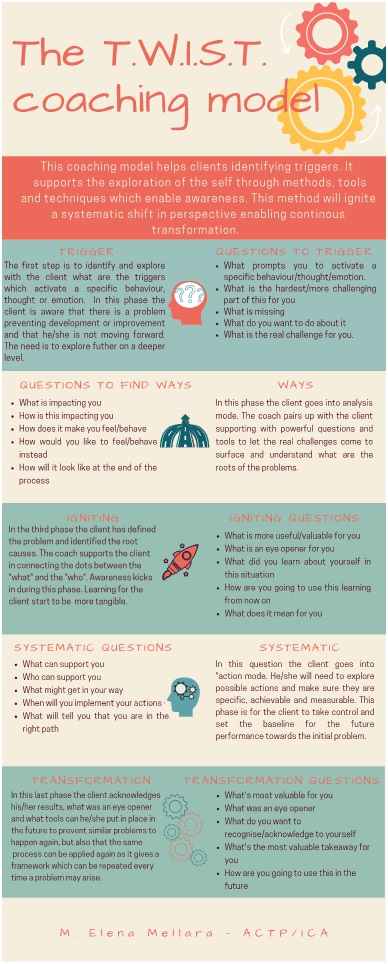A Coaching Model Created by Maria Elena Mellara
(Career Coach, NETHERLANDS)
Introduction
When working in a corporate environment some tools just permeate in the skin of the associates and they are used constantly. Lean 6 Sigma DMAIC model is used to improve the quality of results that the company processes produce[1].
The acronym stands for: Define, Measure, Analyze, Improve, Control.
The model can be infinitely applied to achieve continuous improvement and generate change within company processes. This model is transforming extremely complex industrial projects and procedures into something simpler, structured, and repeatable.
The T.W.I.S.T. coaching model
The challenge is transposing a successful corporate model into a coaching model to impact people, rather than industrial processes.
Transposing the D.M.A.I.C. into coaching leads to the creation of a new coaching model: the T.W.I.S.T.
The acronym stands for: Trigger Ways Igniting Systematic Transformation.
The T.W.I.S.T model helps the client identify the issue – or issues – bothering and preventing him/her from moving forward. Through the coaching techniques and powerful questions, the client will evaluate multiple sources of information and will be able to make interpretations gaining awareness, and achieve agreed-upon results.[3] The achieved awareness will ignite a systematic shift in perspective which will help the client set in motion the personal transformation. The model can be repeated each time a new challenge will be presented in front of the client.
Trigger
The first step is to identify and explore with the client what are the triggers which activate a specific behavior, thought, or emotion. Like in the “D”and the “M” of the DMAIC process, in this phase the client is aware that there is a problem preventing development or improvement and that s/he is not moving forward. The need is to explore further on a deeper level to quantify the impact of the triggers on the problem.
Trigger questions
Ways
Once that the triggers have been identified, the client goes into analysis mode – the “A” of DMAIC. In this phase, the coach pairs up with the client supporting powerful questions and tools to let the real challenges come to the surface and understand what are the roots of the problem(s).
Ways questions
Igniting
In this third phase – which can be identified with the “I” in the DMAIC – the client has defined the problem and identified the root causes. The coach supports the client in “connecting the dots” between the “what” and the “who” and invites him/her to explore in more depth the situation as well as the learning about him/herself. Awareness kicks in during this phase.
Igniting questions
Systematic
In the Systematic phase, the client goes into action mode. S/he will need to explore possible actions and make sure they are specific, achievable, measurable, and time-bound. Like in the “C” of the DMAIC, this phase is to take control and set the baseline for the future performance towards the initial problem.
Systematic questions
Transformation
In this last phase, the client acknowledges his/her results, what was an eye-opener and what tools can s/he put in place in the future to prevent similar problems to happen again, but also that the same (T.W.I.S.T.) process can be applied again as it gives a framework which can be repeated every time a problem may arise.
Transformation questions

References
LEAN 6 SIGMA: https://www.theleansixsigmacompany.co.uk/dmaic-model/
DMAIC: https://www.dummies.com/careers/project-management/six-sigma/the-dmaic-method-of-six-sigma/
ICF Competencies: https://learnsite.icacoach.com/english-campus/icf-competencies/8-creating-awareness/